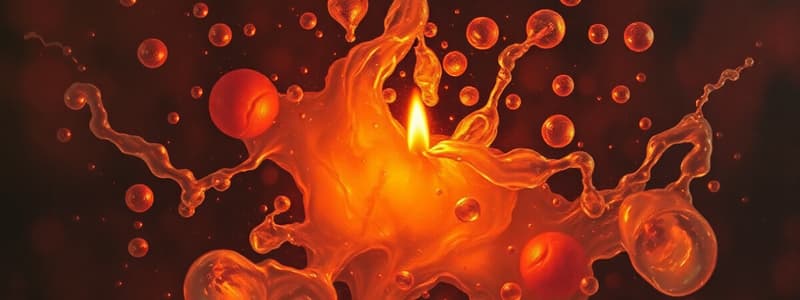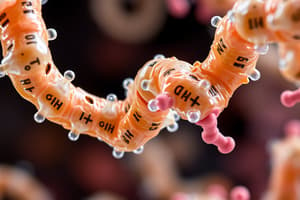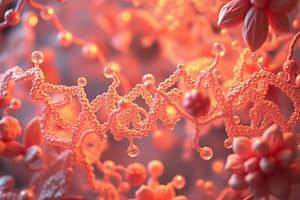Podcast
Questions and Answers
What is a major advantage of the adsorption method for enzyme immobilization?
What is a major advantage of the adsorption method for enzyme immobilization?
- It requires several complex reagents.
- It is easy to carry out and requires no reagents. (correct)
- It provides a stable immobilization through covalent bonds.
- It allows for large particle sizes for optimal bonding.
Which bond types are considered weak bonds in the adsorption method of enzyme immobilization?
Which bond types are considered weak bonds in the adsorption method of enzyme immobilization?
- Ionic interactions and hydrogen bonds. (correct)
- Metal bonding and chelation.
- Covalent bonds and disulfide bonds.
- Ester bonds and ether bonds.
Which of the following is NOT a characteristic of the covalent bonding method of enzyme immobilization?
Which of the following is NOT a characteristic of the covalent bonding method of enzyme immobilization?
- It involves the formation of strong covalent bonds.
- It requires specific chemical conditions for bonding.
- It provides more stable enzyme binding.
- It is less widely used compared to adsorption. (correct)
What is a common disadvantage of the adsorption method for enzyme immobilization?
What is a common disadvantage of the adsorption method for enzyme immobilization?
Which method involves enclosing enzymes within a network or matrix?
Which method involves enclosing enzymes within a network or matrix?
What is one of the methods used within the entrapment technique for enzyme immobilization?
What is one of the methods used within the entrapment technique for enzyme immobilization?
Which of the following methods is identified as the oldest technique of enzyme immobilization?
Which of the following methods is identified as the oldest technique of enzyme immobilization?
Which type of support is NOT typically used in adsorption for enzyme immobilization?
Which type of support is NOT typically used in adsorption for enzyme immobilization?
Which of the following is NOT an advantage of covalent bonding in enzyme immobilization?
Which of the following is NOT an advantage of covalent bonding in enzyme immobilization?
What is a common method of entrapment for enzyme immobilization?
What is a common method of entrapment for enzyme immobilization?
Which of the following describes a disadvantage of entrapment?
Which of the following describes a disadvantage of entrapment?
What is a significant risk associated with using polyfunctional reagents in cross-linking?
What is a significant risk associated with using polyfunctional reagents in cross-linking?
Which chemical groups are involved in forming covalent bonds with enzyme supports?
Which chemical groups are involved in forming covalent bonds with enzyme supports?
Which of the following is a common polymer matrix used for enzyme entrapment?
Which of the following is a common polymer matrix used for enzyme entrapment?
What is a primary advantage of encapsulation in enzyme immobilization?
What is a primary advantage of encapsulation in enzyme immobilization?
What is a disadvantage of covalent bonding when immobilizing enzymes?
What is a disadvantage of covalent bonding when immobilizing enzymes?
What is a primary advantage of immobilizing enzymes?
What is a primary advantage of immobilizing enzymes?
Which method of enzyme immobilization involves trapping enzymes within a solid matrix?
Which method of enzyme immobilization involves trapping enzymes within a solid matrix?
What is a disadvantage of using immobilized enzymes?
What is a disadvantage of using immobilized enzymes?
Covalent bonding in enzyme immobilization typically enhances which characteristic?
Covalent bonding in enzyme immobilization typically enhances which characteristic?
Which application of immobilized enzymes is NOT mentioned in the content?
Which application of immobilized enzymes is NOT mentioned in the content?
In terms of enzyme immobilization, adsorption is characterized primarily by:
In terms of enzyme immobilization, adsorption is characterized primarily by:
What is the impact of immobilization on product contamination?
What is the impact of immobilization on product contamination?
Which of the following is a reason why the applications of immobilized enzymes are limited?
Which of the following is a reason why the applications of immobilized enzymes are limited?
Which of the following is a potential drawback of pesticide use?
Which of the following is a potential drawback of pesticide use?
What is the impact of higher degrees of chlorination on the degradation of saturated halogenated compounds under aerobic conditions?
What is the impact of higher degrees of chlorination on the degradation of saturated halogenated compounds under aerobic conditions?
Which microorganism is known to effectively degrade Pentachlorophenol (PCP)?
Which microorganism is known to effectively degrade Pentachlorophenol (PCP)?
Which pesticide family is known for its potential persistence and bioaccumulation in the environment?
Which pesticide family is known for its potential persistence and bioaccumulation in the environment?
What type of herbicides are known to selectively kill broadleaved weeds?
What type of herbicides are known to selectively kill broadleaved weeds?
What environmental conditions are initially required for the degradation of DDT?
What environmental conditions are initially required for the degradation of DDT?
Which pesticide subclass is considered to be less toxic than organophosphates?
Which pesticide subclass is considered to be less toxic than organophosphates?
Which of the following is NOT a classification criterion for pesticides?
Which of the following is NOT a classification criterion for pesticides?
How are chlorinated cyclic-aliphatic pesticides primarily degraded?
How are chlorinated cyclic-aliphatic pesticides primarily degraded?
Which of the following insecticides operates by disrupting the sodium/potassium balance of nerve fibers?
Which of the following insecticides operates by disrupting the sodium/potassium balance of nerve fibers?
What is a common use of pesticides in agriculture?
What is a common use of pesticides in agriculture?
What is a characteristic of biopesticides?
What is a characteristic of biopesticides?
Which chemical family of herbicides includes compounds such as atrazine and diuron?
Which chemical family of herbicides includes compounds such as atrazine and diuron?
What type of pesticides are commonly used for weed control in agriculture?
What type of pesticides are commonly used for weed control in agriculture?
Which type of insect can pesticides help protect animals from?
Which type of insect can pesticides help protect animals from?
Which of the following is NOT considered a pest for the purpose of pesticide classification?
Which of the following is NOT considered a pest for the purpose of pesticide classification?
What function do herbicides like glyphosate serve in pest control?
What function do herbicides like glyphosate serve in pest control?
Which pesticide type is specifically designed to target bacterial organisms?
Which pesticide type is specifically designed to target bacterial organisms?
What potential risk is associated with the use of pesticides?
What potential risk is associated with the use of pesticides?
Which environmental impact is most commonly linked to herbicides?
Which environmental impact is most commonly linked to herbicides?
What type of pesticide would be used to control algae in water bodies?
What type of pesticide would be used to control algae in water bodies?
Which class of pesticides is estimated to have saved millions of lives by preventing disease transmission?
Which class of pesticides is estimated to have saved millions of lives by preventing disease transmission?
Which pesticide type is effective against insects like termites?
Which pesticide type is effective against insects like termites?
What are organophosphates primarily used for?
What are organophosphates primarily used for?
Flashcards
Enzyme Immobilization
Enzyme Immobilization
The process of attaching enzymes to a solid support or matrix to improve their stability and reusability.
Immobilization Matrix
Immobilization Matrix
A material that holds the enzyme in a fixed position during the immobilization process.
Adsorption (Immobilization)
Adsorption (Immobilization)
Attaching enzymes to a support surface through weak bonds like ionic interactions, hydrogen bonds, or van der Waals forces.
Covalent Bonding (Immobilization)
Covalent Bonding (Immobilization)
Signup and view all the flashcards
Carrier Binding
Carrier Binding
Signup and view all the flashcards
Support Material Types
Support Material Types
Signup and view all the flashcards
Entrapment (Immobilization)
Entrapment (Immobilization)
Signup and view all the flashcards
Detergent Industry Application
Detergent Industry Application
Signup and view all the flashcards
Advantages of Covalent Bonding
Advantages of Covalent Bonding
Signup and view all the flashcards
Disadvantages of Covalent Bonding
Disadvantages of Covalent Bonding
Signup and view all the flashcards
Advantages of Entrapment
Advantages of Entrapment
Signup and view all the flashcards
Disadvantages of Entrapment
Disadvantages of Entrapment
Signup and view all the flashcards
Cross-linking (Immobilization)
Cross-linking (Immobilization)
Signup and view all the flashcards
Disadvantages of Cross-linking
Disadvantages of Cross-linking
Signup and view all the flashcards
Immobilization Advantages
Immobilization Advantages
Signup and view all the flashcards
Immobilization Disadvantages
Immobilization Disadvantages
Signup and view all the flashcards
Biomedical Applications
Biomedical Applications
Signup and view all the flashcards
Industrial Production
Industrial Production
Signup and view all the flashcards
Food Industry Applications
Food Industry Applications
Signup and view all the flashcards
Waste Water Management
Waste Water Management
Signup and view all the flashcards
Textile Industry Applications
Textile Industry Applications
Signup and view all the flashcards
Pesticide
Pesticide
Signup and view all the flashcards
Biopesticides
Biopesticides
Signup and view all the flashcards
Synthetic Pesticides
Synthetic Pesticides
Signup and view all the flashcards
Halogenated Aromatic Pesticides
Halogenated Aromatic Pesticides
Signup and view all the flashcards
Degradation of Pesticides
Degradation of Pesticides
Signup and view all the flashcards
Anaerobic Degradation
Anaerobic Degradation
Signup and view all the flashcards
Aerobic Degradation
Aerobic Degradation
Signup and view all the flashcards
Chlorination and Pesticide Degradation
Chlorination and Pesticide Degradation
Signup and view all the flashcards
What is a pesticide?
What is a pesticide?
Signup and view all the flashcards
What are the main insecticide families?
What are the main insecticide families?
Signup and view all the flashcards
What are organochlorines?
What are organochlorines?
Signup and view all the flashcards
How do organophosphates and carbamates work?
How do organophosphates and carbamates work?
Signup and view all the flashcards
What are some examples of herbicide families?
What are some examples of herbicide families?
Signup and view all the flashcards
How do phenoxy compounds work?
How do phenoxy compounds work?
Signup and view all the flashcards
Why are pesticides important?
Why are pesticides important?
Signup and view all the flashcards
What are the drawbacks of pesticide use?
What are the drawbacks of pesticide use?
Signup and view all the flashcards
What are herbicides?
What are herbicides?
Signup and view all the flashcards
What are pesticides?
What are pesticides?
Signup and view all the flashcards
Types of Pesticides
Types of Pesticides
Signup and view all the flashcards
What are organophosphates?
What are organophosphates?
Signup and view all the flashcards
What are the risks of pesticide use?
What are the risks of pesticide use?
Signup and view all the flashcards
What is the EPA?
What is the EPA?
Signup and view all the flashcards
How do herbicides affect plant growth?
How do herbicides affect plant growth?
Signup and view all the flashcards
What is the impact of pesticides on human health?
What is the impact of pesticides on human health?
Signup and view all the flashcards
Study Notes
Enzyme Immobilization Techniques
- Enzymes are biological catalysts that promote chemical reactions in living organisms.
- Enzymes can catalyze reactions under mild conditions with high substrate specificity, reducing by-product formation.
- Enzymes can exist as individual molecules in solution, in aggregates with other entities, or attached to surfaces.
- Immobilized enzymes are physically confined or localized, retaining their catalytic activity for repeated and continuous use.
- Immobilization techniques offer advantages like reusability, continuous use, reduced labor, lower capital costs, faster reaction times, and reduced contamination.
Immobilization Techniques: Advantages
- Reuse: Immobilized enzymes can be used repeatedly, reducing costs compared to free enzymes.
- Continuous use: Continuous operation is possible, unlike using free enzymes.
- Less labor: Requires less labor for repetitive tasks.
- Savings in capital cost/investment: Reduced enzyme replacement costs.
- Minimal reaction time: Faster reactions due to stable and controlled conditions.
- Less chance of contamination in products: Prevention of contamination improves product quality.
- More stability: Enzymes stay stable under process conditions.
- Improved process control: Precise control over reaction conditions.
- High enzyme substrate ratio: Optimal enzyme activity through efficient use
Immobilization Techniques: Disadvantages
- Limited uses in industrial applications: May not be suitable for all industrial processes.
- Loss of catalytic properties: Some enzymes lose activity when immobilized.
- Enzyme instability: Some immobilized enzymes become unstable over time.
- Enzyme inactivation: Heat generation in the system can inactivate enzymes.
- High cost of isolation, purification, and recovery: Increased costs for preparing immobilized enzymes.
Immobilization Techniques: Applications
- Industrial Production: Used in antibiotics, beverages, and amino acid production.
- Biomedical Applications: Treatment, diagnosis, and drug delivery.
- Food Industry: Production of preserves like jams, jellies, and syrups.
- Research: Used in blotting experiments, protease for cell lysis, and biodiesel production from vegetable oils.
- Wastewater Management: Used in sewage and industrial effluent treatment.
- Textile Industry: Scouring, bio-polishing, and desizing of fabrics.
- Detergent Industry: Used with lipase for effective dirt removal.
Immobilization Techniques: Supports/Matrix
- The matrix/support holds the enzyme.
- It should be cheap, readily available, and minimize reactions with the medium and enzyme.
- Wide variety of matrices used in the immobilization of enzymes/whole cells.
- Matrices are categorized into natural polymers, synthetic polymers, and inorganic materials.
Immobilization Techniques: Methods
- Adsorption: Enzymes adhere to the support's surface via weak bonds (e.g., ionic interactions, hydrogen bonds, van der Waals forces).
- Advantages: Simple, inexpensive, and avoids denaturing enzymes.
- Disadvantages: Lower enzyme stability and potential desorption.
- Covalent Bonding: Enzymes are covalently linked to the support through chemical bonds.
- Advantages: High stability, low leakage.
- Disadvantages: Potential for enzyme modification and reduced activity.
- Entrapment: Enzymes are physically enclosed within a matrix (e.g., gels, fibers, microcapsules).
- Advantages: Quick, cost-effective, mild conditions, reduced conformational changes.
- Disadvantages: Enzyme leakage, pore diffusion issues and microbial contamination.
- Cross-linking (Copolymerization): Enzymes are linked together via polyfunctional reagents to enhance stability.
- Advantages: More stable than adsorption and simple.
- Disadvantages: Reagents can denature the enzyme
Immobilization Techniques: Encapsulation
- Enclosing enzymes within a semi-permeable membrane capsule.
- The capsule is usually made of nitrocellulose or nylon.
- Effectiveness depends on enzyme stability in the capsule.
- Advantages: Simple method, large quantities of enzymes can be immobilized.
- Disadvantages: Limited pore size restricts substrate entry, and some substrate molecules may not be able to cross the membrane.
Immobilization of Cells
- An alternative approach to enzyme immobilization.
- Suitable for utilizing enzymes from microbes when individual enzymes are unstable or isolating/purifying them is uneconomical.
- Methods are similar to enzyme immobilization (adsorption, covalent bonding, entrapment, etc).
- Whole-cell immobilization advantages include introducing multiple enzymes, avoiding purification steps, and maintaining original enzyme conformations.
- Disadvantages include potential for lower enzyme concentration and possible unwanted enzyme production.
Studying That Suits You
Use AI to generate personalized quizzes and flashcards to suit your learning preferences.





